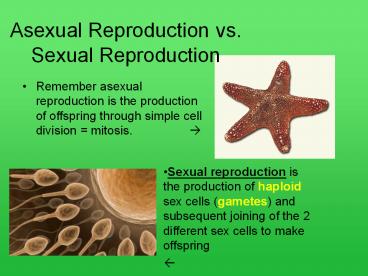Asexual Reproduction vs. Sexual Reproduction - PowerPoint PPT Presentation
1 / 15
Title:
Asexual Reproduction vs. Sexual Reproduction
Description:
A. Meiosis put together new combinations of. genes/chromosomes. This allows for . genetic recombination or mixing or genes. B. Meiosis occurs in: sex cells or gametes – PowerPoint PPT presentation
Number of Views:67
Avg rating:3.0/5.0
Title: Asexual Reproduction vs. Sexual Reproduction
1
Asexual Reproduction vs. Sexual Reproduction
- Remember asexual reproduction is the production
of offspring through simple cell division
mitosis. ?
- Sexual reproduction is the production of haploid
sex cells (gametes) and subsequent joining of the
2 different sex cells to make offspring - ?
2
Diploid Cells vs. Haploid Cells
- Sexually reproductive organisms have two types of
cells that they can reproduce DIPLOID and
HAPLOID. - DIPLOID a cell with 2 of each kind of chromosome
(i.e. 2 of chromosome I, 2 of chromosome II,
etc.) where one is from mom and the other is from
dad represented by 2n, examples all body cells
in animals and plants except the sex cells - HAPLOID a cell with only 1 of each kind of
chromosome, represented by n examples sex cells
(sperm and egg in mammals, pollen and egg in
plants)
3
FERTILIZATION PROCESS
- Sperm (haploid) are male gametes
- Eggs (haploid) are female gametes
- Sperm Egg Fertilization
- Fertilization the process of a sperm and an egg
fusing together to form a diploid zygote
4
Process of Meiosis
- Meiosis the formation of haploid gametes (sex
cells) - Cells in the gonads (boys testes, girls
ovaries) will undergo meiosis when they need to
produce gametes for sexual reproduction. - Males Make 4 sperm in meiosis
- Females Make 1 egg and 3 polar bodies in meiosis
5
Process of Meiosis
- Meiosis divides the chromosomes differently
during the phases to ensure that there are 4 new
cells produced, each genetically different, with
half of the chromosomes that the body cells have. - Steps of MEIOSIS Interphase ? Prophase 1 ?
- Metaphase 1 ? Anaphase 1? Telophase 1 ?
- Prophase 2 ? Metaphase 2 ? Anaphase 2 ?
- Telophase 2
- (DNA is still duplicated/replicated during
Interphase) - End Results 4 genetically different sex cells
6
PROPHASE 1 of Meiosis
Homologous chromosomes -the 2 chromosomes of a
pair in a diploid cell (remember, one from mom
and one from dad), humans for instance have 46
chromosomes, 23 homologous pairs
- ½ of your chromosomes in a cell (23) come from
MOM and the other half (23) come from DAD. This
totals to your 46 chromosomes per cell. - During prophase these chromosomes pair up in
their homologous pairs and form tetrads. - Each tetrad has a chromosome from MOM and the
matching chromosome from DAD.
7
Crossing Over
- While the homologous chromosomes are in their
tetrads, the ends of the chromosomes that overlap
will break off certain pieces and exchange them
with the homologous chromosome. - This process is called CROSSING OVER.
- This process is why 4 genetically DIFFERENT sex
cells are produced.
8
Anaphase/Telophase 1
- During these phases, homologous chromosome pairs
separate, cutting the number of chromosomes in
each resulting cell in half.
9
(No Transcript)
10
Meiosis 2(Prophase 2 ? Metaphase 2 ? Anaphase 2
? Telophase 2)
- Meiosis 2 is exactly like Mitosis
- The chromosomes will line up in a single file
line along the equator during Metaphase 2, sister
chromatids will separate during Anaphase 2, and
each cell will make 2 cells during Telophase 2)
11
http//highered.mcgraw-hill.com/sites/0072495855/s
tudent_view0/chapter28/animation__how_meiosis_work
s.html
12
(No Transcript)
13
Animation Comparing Mitosis and Meiosis
14
How is Meiosis Different than Mitosis?
- Meiosis has 2 divisions
- Meiosis produces 4 new cells
- Meiosis produces genetically different cells
- Meiosis occurs only in the gonads
15
Nondisjunction the failure of chromosomes to
separate properly during meiosis creates genetic
abnormalities where some cells have too many
chromosomes and others possibly have too
few Example Downs Syndrome































